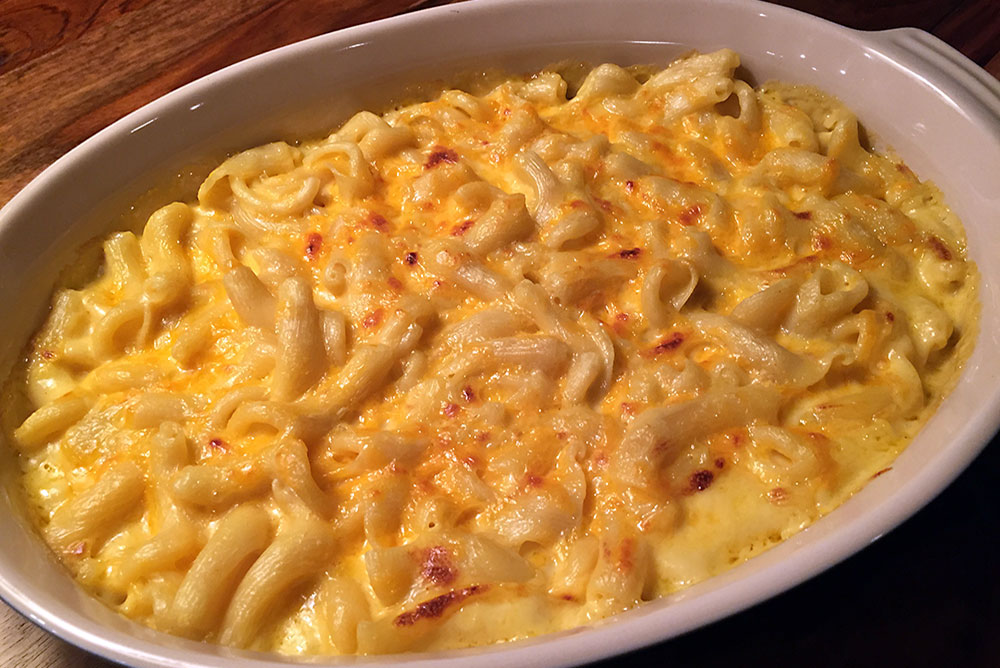
Ah, mac and cheese! / Photo by Stephanie Witt Sedgwick.
MANY YEARS AGO, when I worked on the staff of the Washington Post Food section, we decided a really great idea for Thanksgiving would be to produce a timeline in which we guided readers through executing the turkey-day dinner on time. We worked on the timeline for many days, and we thought we had it all covered: We had the turkey cooking, gravy made, stuffing, side dishes, the works.
That was, until the paper hit the streets—yes, it was when the paper version was the only version. The phones started ringing first thing in the morning. The callers all had the same complaint: We had left out a key dish—the macaroni and cheese. What could I say? It had never occurred to me. Mac and cheese wasn’t part of my family’s tradition, and for me it wasn’t a holiday dish. It wasn’t even something you planned on. From a box or from scratch, macaroni and cheese was the best-ever emergency meal.
When I was growing up, it was the mac and cheese in a box that saved my mother. It was one of the first things I could make all on my own. As I got more skilled, I learned how to make the from-scratch kind and I was hooked.
And for many years, it has been my dinner on the fly. I’d make the key components—the cheese sauce and the pasta—in the morning, and refrigerate the sauce and pasta separately. When we rushed into the house after a baseball game, music lesson or meeting, I’d mix the pasta and sauce together, pour the combo into a shallow casserole dish and transfer it to the preheated oven. Add a salad and some sliced fruit and dinner was ready.
While the basics of making mac and cheese don’t vary much, everyone has their own take. Some cooks like a cream-based sauce, but I use a classic béchamel, a milk sauce thickened with a roux, a mix of butter and flour. I use the béchamel because I like it but also because I have always have flour, butter and milk in the house, whereas cream is a specialty item. Once the sauce is made and seasoned, I slowly add the cheese into the cheese sauce with the heat set no higher than medium-low. Adding the cheese slowly is key: It keeps the sauce from getting grainy. I taste as I go along, so I add enough cheese to make the sauce have that depth of flavor with getting too goopy.
Now, people debate which kind of cheese is best, how many cheeses to use, which cheese melts the best, etc. I use what I have because I have discovered the absolute hands-down secret to great mac and cheese is to keep it saucy. Plenty of different cheeses will work, but if your mac and cheese is dry, you’ve ruined it. This is not a dish that calls out for restraint—you want plenty of sauce. To that end, I add the pasta to the sauce, and not the other way around. That way I can stop adding the pasta while combo still looks saucy.
My basic formula for a large pan of mac and cheese is:
1 pound pasta, cooked and drained
1 pound grated cheese
4 cups hot milk
5 tablespoons butter
6 to 7 tablespoons flour
The butter is melted in a 3-quart pot over medium heat. Add flour until the roux has the consistency of wet mud. Let it cook for a minute, then slowly add about 3 cups of the heated milk, whisking constantly. Keep whisking and the sauce will thicken as it starts to simmer. Add more milk as needed. You want the sauce to completely coat the back of spoon. Season with salt, pepper and whatever else you’d like. Reduce heat to medium-low and slowly add the grated cheese. Remove from heat as soon as you have the sauce where you want it. Transfer to a large bowl and add ¾ of the cooked pasta. If the mixture is still too saucy, continue adding pasta. The mix goes into a large shallow casserole dish or two smaller dishes. It will need to bake in a 375-degree oven until bubbly, about 20 to 25 minutes. Then run it under the broiler.
The last controversial element is the topping. I like to top simply with some of the grated cheese. Many like to use buttered breadcrumbs or crushed crackers, or a combination of chopped nuts and crumbs, or bacon and crumbs. I could go on and on, but it’s up to you.
My kids are teenagers now and the crazy nights are fewer and farther in between. Mac and cheese has made the leap from emergency food to a special family favorite. So now, for all those readers who were so adamant about mac and cheese as a holiday dish, I’m right there with you.
Everyone has a favorite version, we’re always torn between the classic, a mix of mild and extra-sharp cheddar; and the Swiss version, Gruyere, Emmentaler or Comte with small chunks of ham and peas. It’s a great debate to have because it means a favorite comfort food is going to be served for dinner.
—Stephanie Witt Sedgwick
LittleBird “Stephanie Cooks” keeps dinner in mind at all times, and shares her thoughts every Monday.
